Published:
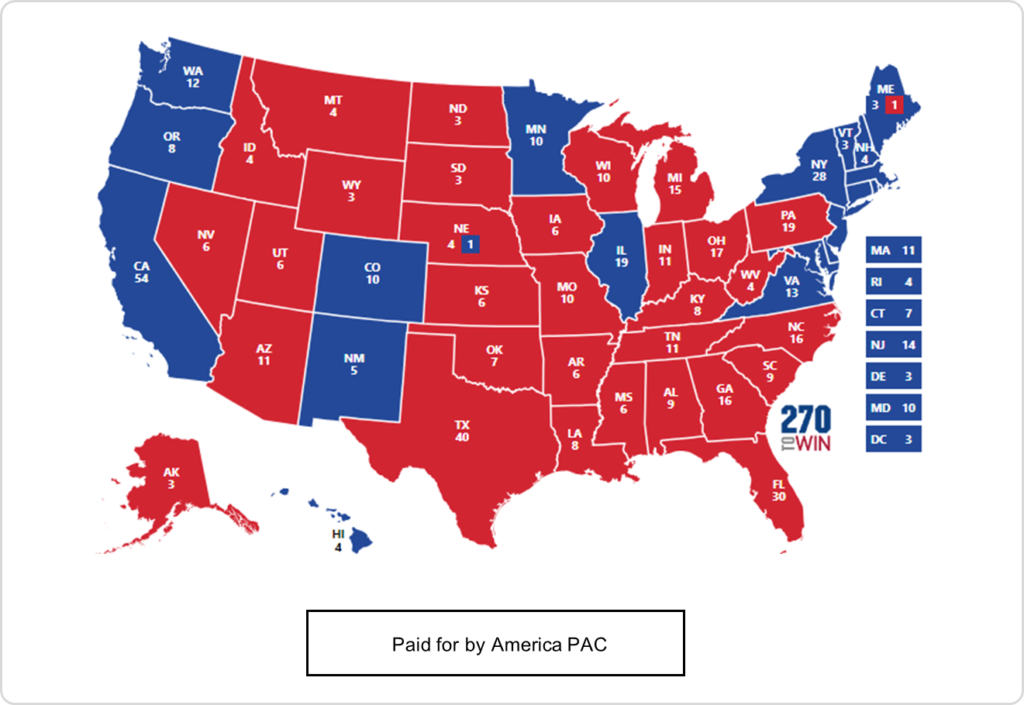
Note: the data used for this story was as of 11/7 and may be updated as revised data is made available.
There is nothing that can shift conventional wisdom (or the fortunes of a small few) more than doing something non-conventional in politics and winning. In 2008, Obama rewrote the rulebook and made a massive canvassing operation mandatory in all future campaigns. In early 2024, the Trump team, after an audit exposed they were spending nearly $100 for every conversation with a voter, abandoned the ground game and relegated it to outside organizations, the most visible being Elon Musk’s America PAC.
As is standard procedure in all post-election commentary, praise is being heaped on every tactic and decision of the winning team, while the losing team could not possibly have made more mistakes. But for the rest of us, we know that decisions and tactics do not always correlate. (See New Coke, Post-it Notes, etc)
Already, heap is being praised on Elon Musk and his America PAC and the role it had on Trump’s victory. It will only build from here.
But, rather than use the lazy shorthand of equating victory with brilliance, to understand if that effort had much of an effect let’s take a deeper dive into the data for the swing states and the races that Musk and America PAC invested in.
America PAC devoted much of its money to the on-the-ground voter mobilization efforts in the seven swing states. We’ve been critical here of door-to-door canvassing in a presidential elections becasue most research, particularly the more recent research, indicates it just doesn’t work in a media saturated, high visibility election such as president.
To be fair, Musk’s PAC didn’t just knock on doors. They employed some fairly novel (and legally questionable) tactics such as offering $47 referral bonuses for swing votes, $100 to sign a petition, and even a million dollar daily lottery. They also ran ad campaigns targeted to low-turnout voters. But door-to-door canvassing was their biggest operation. So, to understand the potential impact Musk and Co had on this election, we need to look more deeply than just ‘Trump won so, therefore…”

The shift was nationwide
There was only a single state that did not perform worse for Harris in 2024 than they did for Biden in 2020, Washington State. The table below shows the margin +/- for the Dems for every state for 2020 Vs 2024 and how much each state shifted their vote (in every case but WA, to the right).
Overall, the average shift to the right was 5.44%, a seismic shift for an electorate. In some states, the shift was somewhat easy to intuit. In West Virginia (17.2%) for example, longtime Senator Joe Manchin is retiring and the coal-heavy state has much to benefit from a Trump term. New Jersey going from +15 to just +5 is getting a lot of ink but even more surprising is California, which shifted over 12% toward Trump from 2020 to 2024 (again, the data may get updated here as time goes on). This table shows the five states with the highest and lowest shifts.
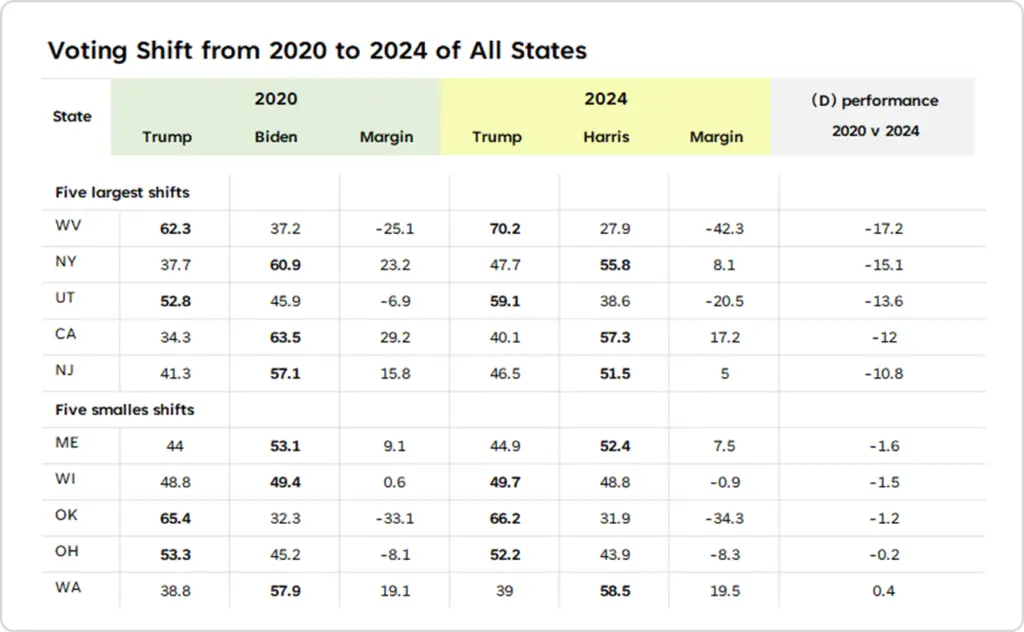
Which brings us back to Musk PAC
Anyone who’s invested in the stock market knows success must be measured not by absolute return but against the overall market. If the market is returning 12% overall, then picking stocks by throwing darts would also return 12% on average – a true but oversimplification.
So, to see how much effect Musk had on the election, we should be able to look at the areas where he and his PAC focused their attention and compare those outcomes to the areas (e.g. states) they did not spend any time or money.
For the presidential, America PAC invested almost exclusively on the seven swing states (AZ, GA, NC, NV, PA, MI, WI). They focused in particular on Pennsylvania. Just before the election, America PAC reported that canvassers had knocked on around 2.3 million doors in Pennsylvania alone.
So what was the effect of all that attention and money on the 7 swing states?
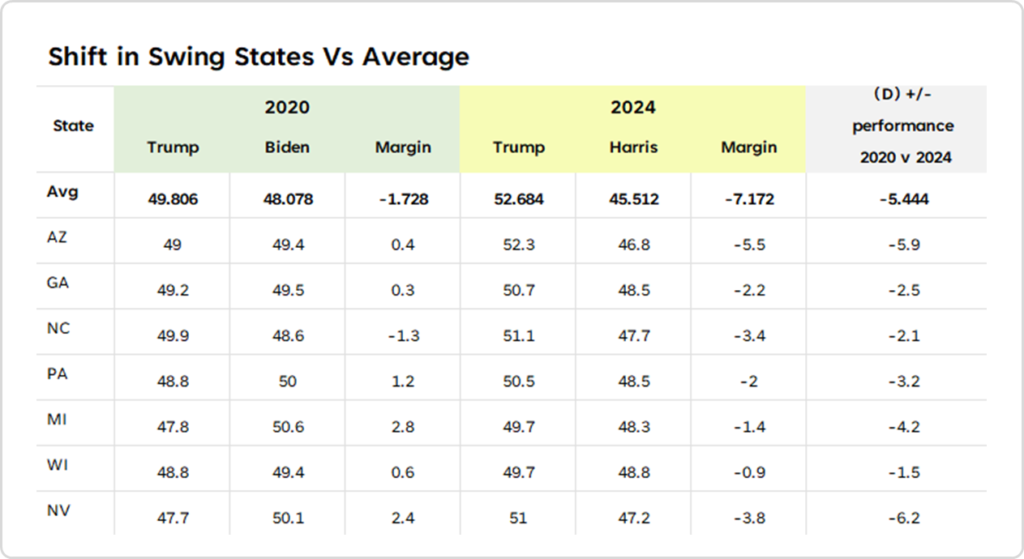
As noted above, there was a near universal shift to the right with the average shift being 5.4%. The swing states where Musk PAC invested heavily significantly underperformed when compared to the average shift. In only a single swing state, Arizona, was the shift higher than the average.
In other words, states with very little direct attention paid to them shifted much more toward Trump than the swing states, e.g. the states where Musk’s PAC invested nearly $200M to get out the vote.
Nothing can be compared and evaluated in a vacuum and there were so many contributing factors. Harris herself spent an enormous time in the swing states so possibly, in the absence of Harris, the efforts of Musk’s PAC could have exceeded the average shift. But the performance of the swing states, as compared to all the other states, cannot be looked at as if some part of a campaign was overly effective. The numbers just don’t bear that out.
How about the House races?
Team Musk didn’t just focus on the presidential. With much less fanfare, they also selected 18 House races to target and invested considerable resources into these as well.
Here are the 18 targeted House races. In each case, we look at the 2020 margin in that House district, the overall shift in that respective state from 2020 to 2024 for the presidential election, to then extrapolate the expected outcome of that House race. There is an obvious presumption here that any given House District will shift in a manner consistent with the overall state.
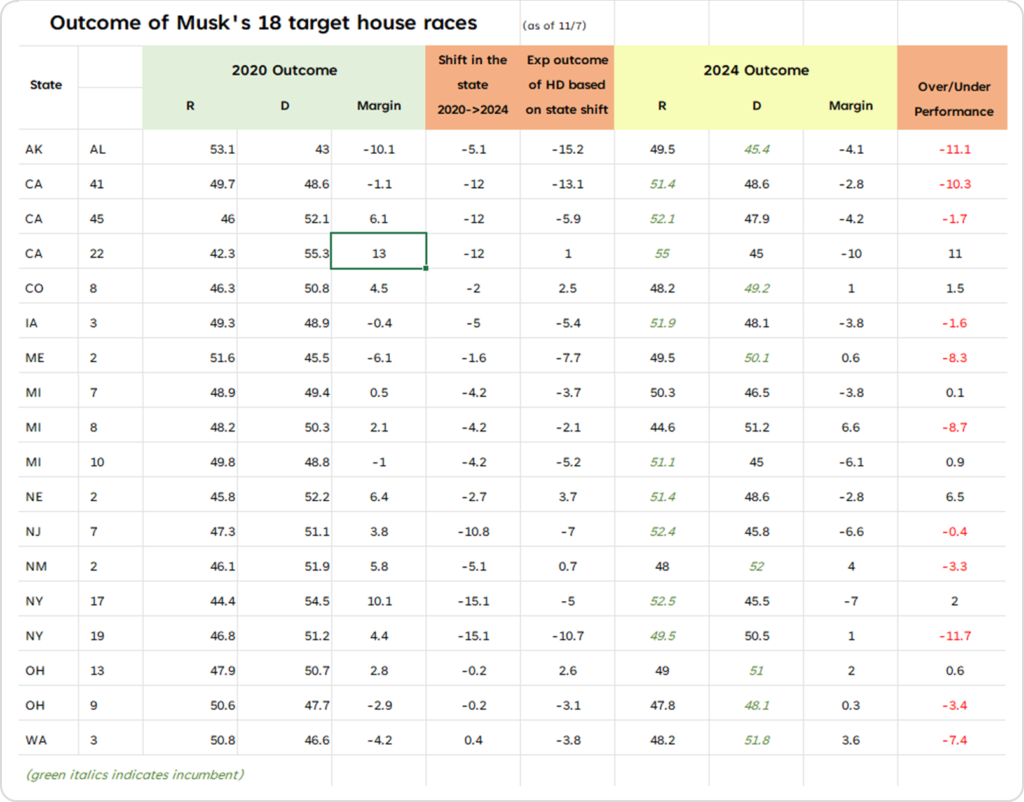
As the data shows, in the 18 House races targeted by America PAC, 11 of them underperformed by an average of 6%, relative to the overall shift in the respective state. Meaning that if a House District voted for the Democrat by +2% in 2020 but there was an overall shift in the state toward Republicans by 5% from 2020 to 2024, then you’d expect that individual House District in 2024 to come in at roughly +3% for the Republican in 2024. That just didn’t happen, despite the enormous resources and attention of Musk and his PAC.
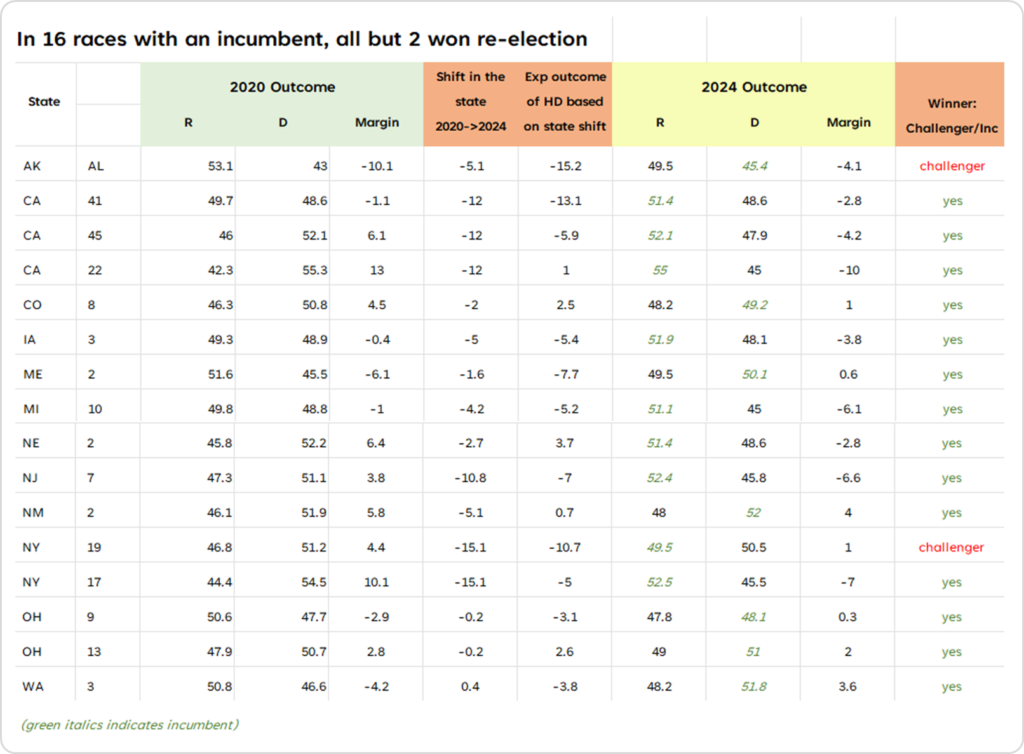
Incumbency seemed much more impactful that Musk.
Of those 18 targeted races, only 2 were open seats, meaning 16 had incumbents. Of those 16, only two challengers won: Rep (AK-AL) and Dem (NY-19). Of the 7 incumbent Democrats, Musk PAC was only able to unseat a single one, Alaska’s at-large seat. In every other contest, Musk’s PAC failed to have an impact on the outcome.
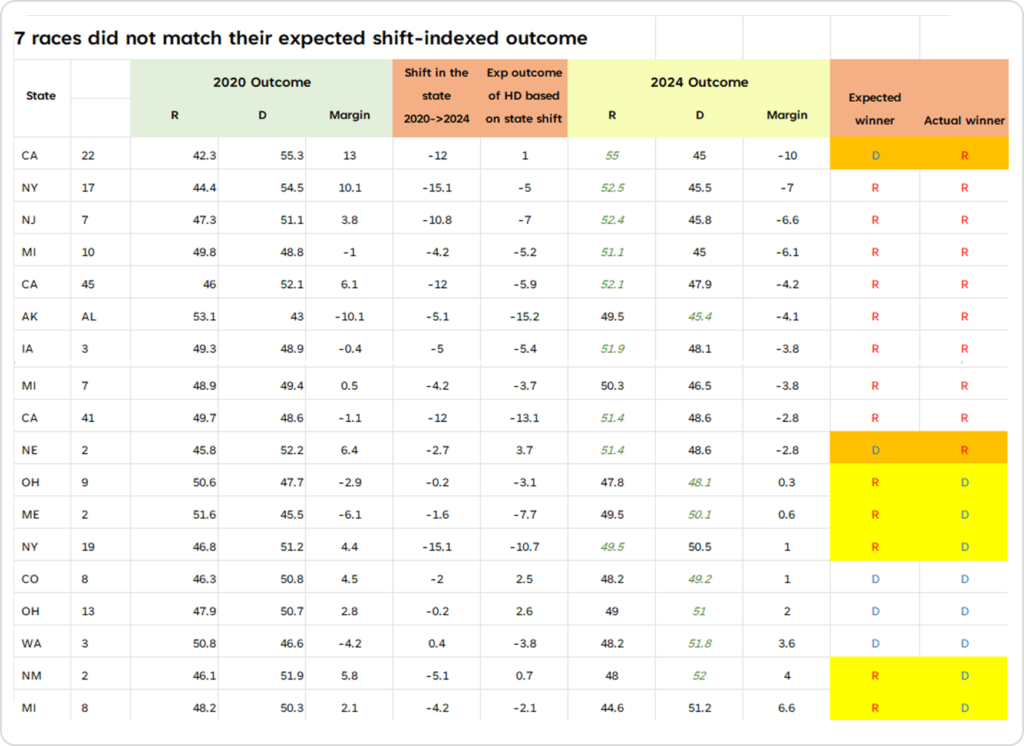
So did America PAC have any effect here? It would seem no. In fact, it would seem the opposite is more true. If you take the shift of the overall state and apply it to the house district, then then 5 races should have gone Republican but instead went Democratic (ME-2, MI-10, NM-2, OH-9, and WA-03 – yellow highlight). Only two races went the against the expected and was won by the Republican (CA-22, NE-2 – orange highlight).
Oracle vs. Dart-Thrower?
There is no question that the election, for Democrats, was nothing short of a bloodbath. The nation turned sharply to the right – everywhere, every state, and every demographic. Democrats will have some serious soul-searching in the days ahead. However, America PAC’s impact on this election doesn’t seem to be anything more than gathering news stories. Going back to the investing metaphor, if you pick a stock that makes 15% this year, great. But if the overall market is up by 22%, then it’s not quite the accomplishment it might seem at first blush.
With all this said, it should be noted though that while’s Musk’s PAC seems to have been mostly ineffective, the same may not be true of the influence of his social media platform X. This was a broad shift, much more in line with X’s audience than a targeted canvassing campaign.
This data can be viewed and downloaded here.
ProgressiveLabs is a Social Benefit Organization, dedicated to helping down-ballot Progressive organizations run effective, optimized campaigns that win on Election Day.